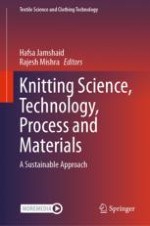2024 | OriginalPaper | Chapter
Knitwear Dyeing: Theory and Sustainability
Authors : Kashif Iqbal, Hafsa Jamshaid, Rajesh Mishra
Published in: Knitting Science, Technology, Process and Materials
Publisher: Springer Nature Switzerland
Activate our intelligent search to find suitable subject content or patents.
Select sections of text to find matching patents with Artificial Intelligence. powered by
Select sections of text to find additional relevant content using AI-assisted search. powered by
